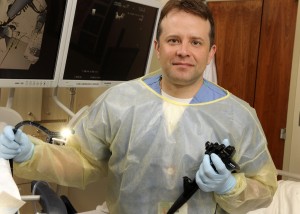
Jennifer Giliberto
Don’t sweat the small stuff.
That’s the motto 36-year-old Jennifer Giliberto now lives by after recently welcoming a third child into the world. Late night feedings, diaper changes, mounds of dirty laundry and caring for two older boys (ages six and eight) would certainly be a challenge for most moms. But this mom is different.
Four years ago, Giliberto was diagnosed with a brain tumor – a slow growing Grade II astrocytoma located in her posterior right temporal lobe. The shocking diagnosis left Giliberto and her family with many choices and decisions to make.
Giliberto’s inspiring story was profiled on CNN on Aug. 16, 2011 in a special “Human Factor†segment, which takes a look at people accomplishing something significant after overcoming the odds.
The Long Road Ahead
After her second child was born in 2005, Giliberto began noticing a pattern of problems with her fine motor skills. Neurological testing revealed little, but an MRI (magnetic resonance imaging) revealed a lesion and possible tumor in the brain. Follow-up MRIs over the next year showed no new growth, but in June 2007, a definite brain tumor was detected by MRI.
While taking the watch and wait approach to determine if the tumor would grow, she became involved with the Southeastern Brain Tumor Foundation (SBTF) as a volunteer. She focused her efforts on raising money to support critical brain and spinal tumor research. She also met Emory neurosurgeon Costas Hadjipanayis, MD, PhD.
Hadjipanayis, an assistant professor in Emory’s Department of Neurosurgery, would soon become Giliberto’s physician. He confirmed her diagnosis and recommended surgical removal of the tumor.

Costas Hadjipanayis, MD, PhD and patient Jennifer Giliberto
On August 18, 2008, at Emory University Hospital Midtown, Hadjipanayis removed Giliberto’s brain tumor. “Jennifer underwent a craniotomy and had a gross total resection of the tumor, with no complications,†explains Hadjipanayis, who is chief of neurosurgery at the hospital. “She spent one night in the neurosurgical ICU and her recovery afterwards went well.â€
Then he encouraged her to embrace life and live it to the fullest. Giliberto has taken her doctor’s orders to heart, and lives life with a new purpose than before.
Giving Back
To support and encourage other brain tumor patients, Giliberto serves as a patient and family advisor at Emory University Hospital Midtown. She visits with hospitalized patients and their families who are in similar situations as the young mother of three.
“This has been a very fulfilling experience and an outlet to give back,†says Giliberto. “Being a patient is lonely, even when you know you have support. Working to assist other patients and families and improve a system goes a long way to ease that lonely journey of the patient experience.â€
Patient and family advisors also work to improve hospital processes and procedures from a patient perspective.
She also serves as vice president of the Southeastern Brain Tumor Foundation, continuing the mission to raise funds for research. The SBTF consistently funds innovative brain tumor research at Emory’s Winship Cancer Institute.
And she is a devoted wife and mother.
Moving Forward
Last year, when Giliberto and her husband decided they would like to expand their family of four, she consulted with Hadjipanayis. He, once again, encouraged her to live life and move forward. They did, and their youngest child was born in July 2011.
While Giliberto has remained stable since her surgery in 2008, she continues to have MRI’s every six to nine months to check for any tumor recurrence. Astrocytomas, even once removed, can recur and can also become cancerous.
But for now, it’s on with life as she knows it – stable, moving ahead and enjoying every day with a new sense of hope.
And as for the small stuff – Giliberto’s learned there’s just no reason to sweat it at all.






















